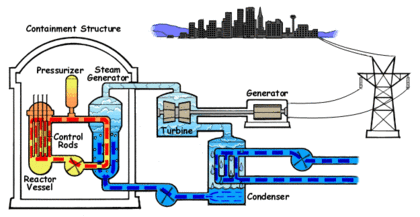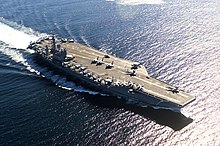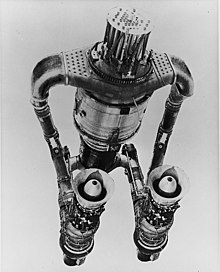Pendorongan nuklear
̺
Pendorongan nuklear merangkumi satu taburan luas kaedah pendorongan yang menggunakan beberapa bentuk tindak balas nuklear sebagai sumber janakuasa utama.[1] Idea untuk menggunakan bahan nuklear bagi tujuan ini telah bermula pada awal kurun ke-20. Pada tahun 1903, satu teori yang mencadangkan penggunaan bahan radioaktif seperti radium, mungkin sesuai digunakan sebagai bahan api untuk enjin pada kereta, kapal terbang, dan bot.[2] H. G. Wells mengambil idea ini dalam kerja fiksyen beliau pada tahun 1914 yang bertajuk The World Set Free.[3] Pada masa kini, kebanyakan kapal selam dan kapal pengangkut pesawat menggunakan uranium sebagai bahan api untuk reaktornya. Oleh itu menjadikan kapal ini dapat beroperasi dalam tempoh yang panjang tanpa perlu mengisi semula bahan api. Terdapat juga penggunaan dalam sektor angkasa di mana enjin-enjin nuklear haba dan nuklear elektrik mungkin lebih efisien berbanding enjin-enjin roket konvensional.

Kapal permukaan, kapal selam dan torpedo


Kebanyakan kapal-kapal berkuasa nuklear terdiri daripada kapal selam dan kapal pengangkut pesawat tentera.[1] Rusia adalah satu-satunya negara yang kini memiliki kapal permukaan awam berkuasa nuklear terutamanya pada kapal pemecah ais. Tentera Laut AS (setakat tahun 2022) memiliki 11 buah kapal induk pesawat dan 70 buah kapal selam yang berada dalam perkhidmatan, kesemuanya dikuasai oleh reaktor nuklear. Untuk perincian lanjut, sila rujuk rencana di bawah:
Kegunaan maritim awam
- Lihat pendorongan marin nuklear
- Senarai kapal berkuasa nuklear awam
Kegunaan maritim ketenteraan
- Senarai reaktor Tentera Laut Amerika Syarikat
- Reaktor Tentera Laut Soviet
- Kapal selam nuklear
Torpedo
Pada 12 November 2015, berita Channel One Television dari Rusia telah menyiarkan sebuah gambar dan perincian sebuah torpedo berkuasa nuklear yang dikenali sebagai Status-6. Torpedo ini dikatakan memiliki jarak sehingga 10,000 km, halaju kruis 100 knot, dan kedalaman operasi sehingga 1000 meter di bawah permukaan. Torpedo ini membawa satu kepala peledak nuklear berkuasa 100-megaton.[4]
Satu cadangan yang muncul pada musim panas tahun 1958 daripada mesyuarat pertama kumpulan penasihat saintifik yang mana kemudian menjadi JASON adalah "sebuah torperdo berkuasa nuklear yang mampu berlegar di lautan hampir selama-lamanya".[5]
Pesawat dan peluru berpandu

Research into nuclear-powered aircraft was pursued during the Cold War by the United States and the Soviet Union as they would presumably allow a country to keep nuclear bombers in the air for extremely long periods of time, a useful tactic for nuclear deterrence. Neither country created any operational nuclear aircraft.[1] One design problem, never adequately solved, was the need for heavy shielding to protect the crew from radiation sickness. Since the advent of ICBMs in the 1960s the tactical advantage of such aircraft was greatly diminished and respective projects were cancelled.[1] Because the technology was inherently dangerous it was not considered in non-military contexts. Nuclear-powered missiles were also researched and discounted during the same period.[1]
Pesawat
- Convair X-6
- Myasishchev M-50 - Aviation Week hoax[7]
- Aircraft Nuclear Propulsion - General Electric's project to build a nuclear-powered bomber
- Tupolev Tu-95LAL
Peluru berpandu
- Project Pluto - which developed the SLAM missile, that used a nuclear-powered air ramjet for propulsion[1]
- Burevestnik nuclear-powered cruise missile announced by Vladimir Putin in 2018.[8]
Kapal angkasa lepas
Many types of nuclear propulsion have been proposed, and some of them (e.g., NERVA) tested for spacecraft applications.[9]
Pendorongan denyutan nuklear
- Project Orion, first engineering design study of nuclear pulse (i.e., atomic explosion) propulsion[10]
- Project Daedalus, 1970s British Interplanetary Society study of a fusion rocket
- Project Longshot, US Naval Academy-NASA nuclear pulse propulsion design
- AIMStar, a proposed Antimatter-catalyzed nuclear pulse propulsion craft that uses clouds of antiprotons to initiate fission and fusion within fuel pellets
- ICAN-II, a proposed crewed interplanetary spacecraft that used the antimatter-catalyzed nuclear pulse propulsion engine as its main form of propulsion
- External Pulsed Plasma Propulsion (EPPP), a propulsion concept by NASA that derives its thrust from plasma waves generated from a series of small, supercritical fission/fusion pulses behind an object in space.[11]
Roket haba nuklear

Bimodal nuclear thermal rockets conduct nuclear fission reactions similar to those employed at nuclear power plants including submarines. The energy is used to heat the liquid hydrogen propellant. Advocates of nuclear-powered spacecraft point out that at the time of launch, there is almost no radiation released from the nuclear reactors. Nuclear-powered rockets are not used to lift off the Earth. Nuclear thermal rockets can provide great performance advantages compared to chemical propulsion systems. Nuclear power sources could also be used to provide the spacecraft with electrical power for operations and scientific instrumentation.[12] Examples:
- NERVA (Nuclear Energy for Rocket Vehicle Applications), a US nuclear thermal rocket program
- Project Rover, an American project to develop a nuclear thermal rocket. The program ran at the Los Alamos Scientific Laboratory from 1955 through 1972.
- Project Timberwind (1987–1991), part of the Strategic Defense Initiative
- RD-0410, a Soviet nuclear thermal rocket engine developed from 1965 through the 1980s
- Demonstration Rocket for Agile Cislunar Operations (DRACO), under development in the 2020s
Ramjet
- Bussard ramjet, a conceptual interstellar fusion ramjet named after Robert W. Bussard.
Direct nuclear
- Fission fragment rocket
- Fission sail
- Fusion rocket
- Gas core reactor rocket
- Nuclear salt-water rocket
- Radioisotope rocket
- Nuclear photonic rocket
Nuclear electric
- Nuclear electric rocket
- Project Prometheus, NASA development of nuclear propulsion for long-duration spaceflight, begun in 2003
Pembangunan Agensi Angkasa Lepas Persekutuan Rusia
Anatolij Perminov, head of the Russian Federal Space Agency, announced[bila?] that it is going to develop a nuclear-powered spacecraft for deep space travel.[13][14] Preliminary design was done by 2013, and 9 more years are planned for development (in space assembly). The price is set at 17 billion rubles (600 million dollars).[15] The nuclear propulsion would have mega-watt class,[16][17] provided necessary funding, Roscosmos Head stated.
This system would consist of a space nuclear power and a matrix of ion engines. "...Hot inert gas temperature of 1500 °C from the reactor turns turbines. The turbine turns the generator and compressor, which circulates the working fluid in a closed circuit. The working fluid is cooled in the radiator. The generator produces electricity for the same ion (plasma) engine..."[18][tiada dalam ayat yang diberikan]
According to him, the propulsion will be able to support human mission to Mars, with cosmonauts staying on the Red planet for 30 days. This journey to Mars with nuclear propulsion and a steady acceleration would take six weeks, instead of eight months by using chemical propulsion – assuming thrust of 300 times higher than that of chemical propulsion.[19][20]
Kenderaan darat
Cars
The idea of making cars that used radioactive material, radium, for fuel dates back to at least 1903. Analysis of the concept in 1937 indicated that the driver of such a vehicle might need a 50-ton lead barrier to shield them from radiation.[21]
In 1941, a Caltech physicist named R. M. Langer espoused the idea of a car powered by uranium-235 in the January edition of Popular Mechanics. He was followed by William Bushnell Stout, designer of the Stout Scarab and former Society of Engineers president, on 7 August 1945 in The New York Times. The problem of shielding the reactor continued to render the idea impractical.[22] In December 1945, a John Wilson of London, announced he had created an atomic car. This created considerable interest. The Minister of Fuel and Power along with a large press contingent turned out to view it. The car did not show and Wilson claimed that it had been sabotaged. A later court case found that he was a fraud and there was no nuclear-powered car.[23][24]
Despite the shielding problem, through the late 1940s and early 1950s debate continued around the possibility of nuclear-powered cars. The development of nuclear-powered submarines and ships, and experiments to develop a nuclear-powered aircraft at that time kept the idea alive.[25] Russian papers in the mid-1950s reported the development of a nuclear-powered car by Professor V P Romadin, but again shielding proved to be a problem.[26] It was claimed that its laboratories had overcome the shielding problem with a new alloy that absorbed the rays.[27]
In 1958, at the height of the 1950s American automobile culture there were at least four theoretical nuclear-powered concept cars proposed, the American Ford Nucleon and Studebaker Packard Astral, as well as the French Simca Fulgur designed by Robert Opron[28][29] and the Arbel Symétric. Apart from these concept models, none were built and no automotive nuclear power plants ever made. Chrysler engineer C R Lewis had discounted the idea in 1957 because of estimates that an 80,000 lb (36,000 kg) engine would be required by a 3,000 lb (1,400 kg) car. His view was that an efficient means of storing energy was required for nuclear power to be practical.[30] Despite this, Chrysler's stylists in 1958 drew up some possible designs.
In 1959 it was reported that Goodyear Tire and Rubber Company had developed a new rubber compound that was light and absorbed radiation, obviating the need for heavy shielding. A reporter at the time considered it might make nuclear-powered cars and aircraft a possibility.[31]
Ford made another potentially nuclear-powered model in 1962 for the Seattle World's Fair, the Ford Seattle-ite XXI.[32][33] This also never went beyond the initial concept.
In 2009, for the hundredth anniversary of General Motors' acquisition of Cadillac, Loren Kulesus created concept art depicting a car powered by thorium.[34]
Lain-lain
The Chrysler TV-8 was an experimental concept tank designed by Chrysler in the 1950s.[1] The tank was intended to be a nuclear-powered medium tank capable of land and amphibious warfare. The design was never mass-produced.[35]
The X-12 was a nuclear powered locomotive, proposed in a feasibility study done in 1954 at the University of Utah.[36]
The Mars rovers Curiosity and Perseverance are powered by a radioisotope thermoelectric generator (RTG), like the successful Viking 1 and Viking 2 Mars landers in 1976.[37][38]
Lihat juga
- Safe Affordable Fission Engine
- Electrically powered spacecraft propulsion
Rujukan
- ^ a b c d e f g Trakimavičius, Lukas. "The Future Role of Nuclear Propulsion in the Military" (PDF). NATO Energy Security Centre of Excellence (dalam bahasa Inggeris). Diarkibkan daripada yang asal (PDF) pada 2021-10-18. Dicapai pada 2021-10-15.
- ^ Some practical uses of radium rays, The Republic, Sunday, September 13, 1903
- ^ The new source of energy, The World Set Free, H G Wells, Collins, London and Glasgow, 1956 edition, page 55
- ^ Russia reveals giant nuclear torpedo in state TV 'leak', BBC news, 12 November 2015 - retrieved 27 November 2015
- ^ Science Magazine, 29 November 1991, p.1284
- ^ Thornton, G; Blumbeg, B. (January 1961). "Aircraft Nuclear Propulsion Heat Transfer Reactor Experiments Fulfill Test Goals". Nucleonics. McGraw-Hill. 19 (1). ISSN 0096-6207.
- ^ Norris, Guy (14 October 2014). "False Starts For Aviation's Atomic Age". Aviation Week. Dicapai pada 17 October 2014.
- ^ Gady, Franz-Stefan (2 March 2018). "Russia Reveals 'Unstoppable' Nuclear-Powered Cruise Missile". The Diplomat. Dicapai pada 26 March 2018.
- ^ Moeckel, W. E. (August 1969). Propulsion Systems for Manned Exploration of the Solar System (NASA TM X-1864) (PDF) (Laporan). U. S. National Aeronautics and Space Administration. Dicapai pada January 15, 2023.
- ^ Schmidt, G. R.; Bonometti, J. A.; Morton, P. J. (July 2000). Nuclear Pulse Propulsion: Orion and Beyond (AIAA 2000-3856) (PDF) (Laporan). Am. Inst. Aero. Astro. Dicapai pada January 15, 2023.
- ^ External Pulsed Plasma Propulsion (EPPP) (PDF) (Laporan). NASA. January 1, 1999. Dicapai pada January 15, 2023.
- ^ Contact: Gynelle C. Steele (July 15, 2005). "F-22 Raptor Stealth". NASA Glenn's Research & Technology. Diarkibkan daripada yang asal pada February 19, 2006. Dicapai pada 2009-07-08.
- ^ "Russian Space Agency Announces Plans to Build Nuclear-Powered Deep Space Rocket". Diarkibkan daripada yang asal pada 2017-04-20. Dicapai pada 2017-04-20.
- ^ Russia And US To Discuss Nuke-Powered Spaceship Project
- ^ Russians to ride a nuclear-powered spacecraft to Mars // 2009
- ^ Page, Lewis (5 April 2011). "Russia, NASA to hold talks on nuclear-powered spacecraft. Muscovites have the balls but not the money". The Register. Dicapai pada 26 December 2013.
- ^ "Interview: Academician Anatoly Koroteyev An Inside Look at Russia's Nuclear Power Propulsion System" (PDF). 21st Century Science and Technology. No. Fall/Winter 2012-2013. 21st Century. 3 December 2012. Dicapai pada 26 December 2013.
- ^ (dalam bahasa Rusia) Academician Anatoly Koroteev: "Nuclear power can provide a qualitative leap in the development of space" Diarkibkan 2014-07-14 di Wayback Machine
- ^ "Space Propulsion for Martian Mission may be Developed in 6-9 Years". Diarkibkan daripada yang asal pada 2011-04-05. Dicapai pada 2011-07-11.
- ^ Russia Leads Nuclear Space Race After U.S. Drops Out
- ^ The Science Review, Issues 1-12, University of Melbourne Science Club, Melbourne University, 1937, page 22
- ^ Automobile Quarterly, Volume 31 Number 1, 1992, pages 14-29
- ^ First Atomic Car "sabotaged", Townsville Daily Bulletin, Queensland, Australia, Monday 3 December 1945 page 2
- ^ "Atomic Car" hoax - Elderly inventor gets goal sentence, Cairns Post, Queensland Australia, Monday 22 July 1946, page 3
- ^ "Benson Ford poses challenge on atomic powered automobiles". The Brooklyn Daily Eagle. October 2, 1951. m/s. 3. Dicapai pada June 4, 2015 – melalui Newspapers.com.

- ^ Reading Eagle, Sunday, February 20, 1955, page 8
- ^ Atom-powered Automobile Claimed Russian, The victoria Advocate, Victoria, Texas, Sunday, January 30, 1955, page 7
- ^ "Radioactive cars of the twentieth century". Diarkibkan daripada yang asal pada 26 October 2018. Dicapai pada 26 April 2012.
- ^ "Une anticipation Simca : la "fulgur"" (dalam bahasa Perancis). Dicapai pada 26 April 2012.
- ^ Hearst Magazines (April 1957). "The Atom powered carPopular Mechanics". Popular Mechanics. Hearst Magazines. m/s. 141.
- ^ Advent of Atom Powered Plane Speeded, Ray Cromley, The Victoria Advocate, Victoria, Texas, Wednesday, June 24, 1959, page 4
- ^ Hanlon, Mike (4 June 2004). "Ford Seattle-ite: one of history's most significant concept cars". Gizmag.com. Dicapai pada 26 April 2012.
- ^ "1962 Ford Seattle-ite XXI". Diarkibkan daripada yang asal pada 12 May 2013. Dicapai pada 26 April 2012.
- ^ WTF? Cadillac World Thorium Fuel Concept?
- ^ Hunnicutt, RP (1990). A History of the American Main Battle Tank, Volume 2: Abrams. United States: Presidio. m/s. 36. ISBN 9780891413882.
- ^ Abel, G.K.; Borst, L.B.; Bowie, D.M.; Petty, K.W.; Stover, B.J.; Van Dilla, M.A. (1954), An Atomic Locomotive, dicapai pada 2023-12-14
- ^ "Multi-Mission Radioisotope Thermoelectric Generator" (PDF). NASA/JPL. January 1, 2008. Diarkibkan daripada yang asal (PDF) pada August 13, 2012. Dicapai pada August 6, 2012.
- ^ "Mars Exploration: Radioisotope Power and Heating for Mars Surface Exploration" (PDF). NASA/JPL. April 18, 2006. Diarkibkan daripada yang asal (PDF) pada October 12, 2012. Dicapai pada September 7, 2009.
Bacaan lanjut
- Bussard, R.; DeLauer, R. (1958). Nuclear Rocket Propulsion (Laporan). McGraw-Hill.
- Bussard, R. (1965). Fundamentals of Nuclear Flight (Laporan). McGraw-Hill.
- Cushin, Harry (April 1951). "Atomic Power — In your car". Motor Trend. Diarkibkan daripada yang asal pada 2015-05-13. Dicapai pada 2012-04-23.
Pautan luar
- Nuclear Space Propulsion: NASA 1968 di YouTube
- S. K. Borowski et al., "Nuclear Thermal Rocket/Vehicle Design Options for Future NASA Missions to the Moon and Mars", U. S. National Aeronautics and Space Administration, NASA-TM-0107071, September 1993.
- RKA home page in English
- (dalam bahasa Jepun) ソヴィエト連邦における宇宙用原子炉の開発とその実用
- (dalam bahasa Rusia) RKA home page in Russian
- Atomic Rockets -- Realistic Designs Diarkibkan 2010-01-06 di Wayback Machine ten speculative concepts from NASA
- RW Bussard, An advanced fusion energy system for outer-planet space propulsion, 2003
- A Survey of Nuclear Propulsion Technologies for Space Applications, A. Micks, March 15, 2013
| ||||||||||||||||










